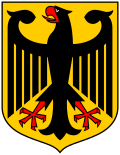| Federal Minister of Intra-German Relations | |
|---|---|
| Bundesminister für innerdeutsche Beziehungen | |
 Coat of arms of Germany. | |
| Status | Abolished |
| Member of | the Cabinet |
| Reports to | the Chancellor |
| Formation | 20 September 1949 |
| First holder | Jakob Kaiser |
| Final holder | Dorothee Wilms |
| Abolished | 9 November 1989 (effectively) 18 January 1991 (formally) |
| Succession | Federal Minister of the Interior |
The Federal Minister of Intra-German Relations (German: Bundesminister für innerdeutsche Beziehungen) was a federal cabinet minister of the Federal Republic of Germany (West Germany). The office was created under the title of Federal Minister of All-German Affairs (Bundesminister für gesamtdeutsche Fragen) in 1949, being also in charge of the German lands east of the Oder–Neisse line which had been put under Polish or Soviet administration. In 1951, the first Minister of All-German Affairs Jakob Kaiser openly raised claim to even greater territories including Austria, parts of Switzerland, the Saar area and Alsace-Lorraine.[1]
The ministry was renamed in 1969 because "All-German" might have evoked irredentist associations. The change of the name was supported by both left- and right-wing politicians.[citation needed]
The ministry was abolished in 1991 when a new government was established after the federal election of December 1990, some months after German reunification, having supported the transition.
Since West Germany maintained an exclusive mandate for all of Germany, and the legal pretense that the authorities of the German Democratic Republic (East Germany) or Soviet occupation zone (SBZ) should not be recognized, it could not handle relations with East Germany through the Federal Foreign Office, since this would acknowledge that the GDR was a separate country. Hence, a separate ministry for relations within Germany had to be created. Since this ministry had very limited competence and virtually no political power, it soon became a post used by chancellors to block rivals without publicly offending them. One of the main tasks of the ministry was the publication of information material about the situation in the East, to keep the idea of German unity alive and to inform the public about actions of the East German government.
When German reunification became a possibility after the fall of the Berlin Wall and the opening of the inner German border on 9 November 1989, the ministry was completely disempowered by Chancellor Helmut Kohl; all intra-German affairs were now handled by the Ministry of the Interior under Wolfgang Schäuble. Formally, the ministry continued to exist until 1991 in order to facilitate transition.
YouTube Encyclopedic
-
1/3Views:1 842 3951 6801 719 252
-
Angela Merkel - Navigating a world in crisis | DW Documentary
-
CGEG: Villy Søvndal, Minister for Foreign Affairs, Denmark
-
The Stasi and the Berlin Wall | DW Documentary
Transcription
Ministers
| No. | Portrait | Name (Birth–Death) |
Term | Political Party | Government | ||
|---|---|---|---|---|---|---|---|
| Took office | Left office | Time in office | |||||
| Federal Minister of All-German Affairs | |||||||
| 1 | Jakob Kaiser (1888–1961) | 20 September 1949 | 29 October 1957 | 8 years, 39 days | CDU | Adenauer I–II | |
| 2 | Ernst Lemmer (1898–1970) | 29 October 1957 | 13 December 1962 | 5 years, 45 days | CDU | Adenauer III–IV | |
| 3 | Rainer Barzel (1924–2006) | 14 December 1962 | 11 October 1963 | 301 days | CDU | Adenauer V | |
| 4 | Erich Mende (1916–1998) | 17 October 1963 | 28 October 1966 | 3 years, 11 days | FDP | Erhard I–II | |
| 5 | Johann Baptist Gradl (1904–1988) | 28 October 1966 | 30 November 1966 | 33 days | CDU | Erhard II | |
| 6 | Herbert Wehner (1906–1990) | 1 December 1966 | 21 October 1969 | 2 years, 324 days | SPD | Kiesinger | |
| Federal Minister of Intra-German Relations | |||||||
| 7 | Egon Franke (1913–1995) | 22 October 1969 | 1 October 1982 | 12 years, 344 days | SPD | Brandt I–II Schmidt I–II–III | |
| 8 | Rainer Barzel (1924–2006) | 4 October 1982 | 29 March 1983 | 176 days | CDU | Kohl I | |
| 9 | Heinrich Windelen (1921–2015) | 30 March 1983 | 11 March 1987 | 3 years, 346 days | CDU | Kohl II | |
| 10 | Dorothee Wilms (born 1929) | 12 March 1987 | 18 January 1991 | 3 years, 312 days | CDU | Kohl III | |
Publications
- BMgF (Hrsg.): SBZ von A-Z, Deutscher Bundes-Verlag, Bonn, 1. bis 10. Aufl., 1953 bis 1966, ca. 500 Seiten.
- BMgF (Hrsg.): Sowjetische Auffassungen zur Deutschlandfrage 1945–1954. Dargestellt nach amtlichen Dokumenten, Deutscher Bundes-Verlag, Bonn, 1954.
- BMgF (Hrsg.): Wer ist wer in der SBZ? Ein biographisches Handbuch, Verlag für Internationalen Kulturaustausch, Berlin, 1958.
- BMgF (Hrsg.): Die Situation der Jugend im kommunistischen Herrschaftssystem der SBZ Deutschlands in Bonner Berichte aus Mittel- und Ostdeutschland, Bonn – Berlin, 1960.
- BMgF (Hrsg.): Die Bemühungen der Bundesrepublik um Wiederherstellung der Einheit Deutschlands durch gesamtdeutsche Wahlen. Dokumente und Akten. I. Teil, Oktober 1949–Oktober 1953, Deutscher Bundes-Verlag, Bonn, 1958.
See also
- Central Registry of State Judicial Administrations, a West German registry to verify East German human rights violations from 1961 until 1992.
- Committee for Reunification / Ministry of Unification, the North / South Korean departments handling similar issues.
- Mainland Affairs Council / Taiwan Affairs Office, the Taiwanese / Mainland Chinese departments handling similar issues.
References
- ^ Speech held at the party congress of Austrian People's Party in Salzburg, 2 March 1951. Quoted in: Neue Zürcher Zeitung, 26 January 1952, page 5










